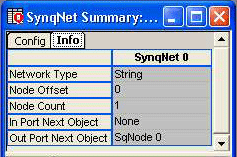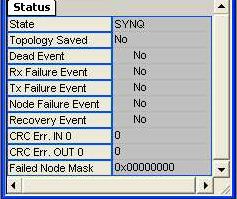
|
|
| . |
SynqNet Objects
|
||||||||||||
|

All Info attributes are read-only.
Network Type – The type of network topology discovered during network initialization (String, Ring, etc.). See MPISynqNetInfo.
Node Offset – The starting number for the first node on the SynqNet network. For example, If SynqNet 0 has three nodes (Node 0-2), then the Node Offset for SynqNet 1 will be 3 because Node 3 is the next available node. See MPISynqNetInfo.
Node Count – Number of Nodes on the SynqNet network. See MPISynqNetInfo.
In Port Next Object – Name of the next network object connected to this object on the In Port. See MPINetworkObjectInfo.
Out Port Next Object – Name of the next object connected to this object on the Out Port. See MPINetworkObjectInfo.
Status attributes are read-only. More information on events can be found under MPIEventType.

State – The state of the SynqNet network. (DISCOVERY, ASYNQ, SYNQ, or SYNQ RECOVERING) See MPISynqNetState for more information.
Topology Saved – Whether or not the SynqNet topology has been saved.
Dead Event – The SynqNet network was shutdown due to a communication failure.
Rx Failure Event – Generated if the controller fails to receive packet data.
Tx Failure Event – Generated if the controller fails to transmit packet data.
Node Failure Event – Generated when any node's upstream or downstream packet error rate counters exceed the failure limit.
Recovery Event – Generated when data traffic is redirected around a faulty node.
CRC Err. IN 0 – The number of CRC errors that are received at the IN port. See CRC Error Counters for more information. See MPISynqNetStatus.
CRC Err. OUT 0 – The number of CRC errors that are received at the OUT port. See CRC Error Counters for more information. See MPISynqNetStatus.
Failed Node Mask – Each bit in this mask represents a failed node (0x1 = node 0, 0x2 = node 2, 0x4 = node 3, etc.). See MPISynqNetFailedNodeMask.
| | | Copyright © 2001-2009 Motion Engineering |